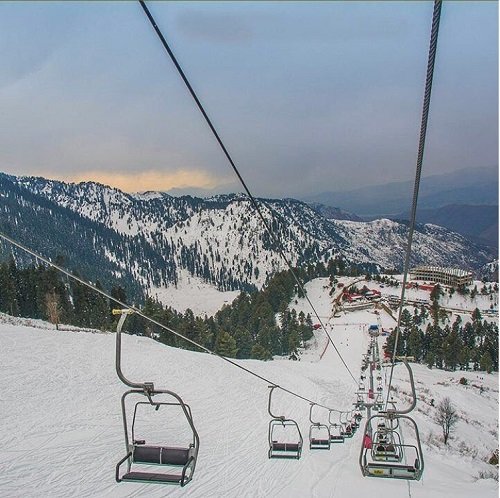Speaking highly of the nature’s bounties, the snow covered peaks and lush green valleys of Azad Kashmir had always been a source of attraction for the nature lovers.
Its soothing and picturesque waterfalls forming into streams and lakes alongside the zigzag roads and crisscross rivers have made Kashmir ‘a heaven on earth,’ with tremendous potential to attract tourists from around the country.
In recent years, after the heavy rush and uncomfortable environment in Murree, Galiat, Nathiagali and Ayubia – the greenish and peaceful mountainous valleys of Azad Kashmir attracted sizeable family tourism.
“We have enchanting sites in Azad Kashmir with tremendous tourism potential. The area is bestowed with nature’s bounties and picturesque destinations,” said Secretary Tourism AJK, Midhat Shahzad.
“In 2018, over 1.4 million tourists visited AJK. The influx of tourists increased to 1.5 million in 2019 and we expected it to touch the two million figures during 2020,” she said. “However, repeated waves of Covid pandemic affected this trend.”
Midhat said keeping in view the potential increase in the number of tourists heading to the region, massive infrastructure was built in recent years, particularly in areas like the Neelum Valley and Poonch. “The government had renovated several tourist resorts at Tatta Pani, Kotli, Poonch and in Muzaffarabad district.”
She said the AJK government had conducted a detailed survey on the development of tourism sector. “Then the Covid surfaced and improvement work slowed down. But, we still have plans to flourish tourism in the region by providing best possible facilities to visitors.”
During the Mughal and British eras, Kashmir was one of the topmost tourist destinations for people of the subcontinent. Later on with the promotion of drama and film industry in subcontinent, it also became an ideal spot for shooting side by side tourism.
The northern part of Azad Jammu and Kashmir encompasses the lower part of the Himalayan, including Jamgarh Peak (15,531 feet, or 4,734 meters). The Sarwali peak in the Neelum Valley is the highest peak in the state.
Beautiful Neelum Valley, Ratti Gali, Pir Chinasi, Banjosa Lake, Nergola Waterfall, Arang Kel, Toli Pir, Jari Kas Park, Dhani Waterfall, Sharda Peeth and much more have emerged as major tourist destinations for domestic as well as foreign tourists.
“Eye catching sites and spots, rich with nature’s bounties always have a soothing effect for me,” said Rashid Mahmood, a tourist who also arranges tourist trips for different parts of Azad kashmir. “Families prefer more to visit destinations in Kashmir.”
He urged the local authorities to preserve nature and environment, ensure peaceful atmosphere and better reaching out infrastructure. “Visitors should be provided homely environment to make them visit these areas again and again.”
Muzaffarabad and Pattan are among the wettest areas. Throughout the region the average rainfall exceeds 1400 mm, with the highest average rainfall occurring near Muzaffarabad.
Like hilly areas of Khyber Pakhtunkhwa and Gilgit-Baltistan region, lot of Kashmiri people earn their living through hotel accommodation, cuisine and food outlets, transport and sale of other traditional cloth and pottery products.
However, tourism industry in Azad Kashmir especially in areas along Line of Control and Neelum Valley often faced challenging times due to unprovoked Indian shelling on Pakistani side of the Kashmir.
Tourism had flourished in Neelum Valley after ceasefire along the line of control (LOC), but Indian aggression once again affected it. Moreover, recent Covid waves also had negative impacts on the industry.
“Earlier, the Indian firing and now the Covid pandemic has affected the tourism industry,” Secretary Tourism Midhat Shahzad said. “Since, most of the tourists come from Punjab and Sindh – lock downs and restricted travelling affected tourists visits as compared to previous years.”
The hospitality industry associated to tourism was especially affected since 2020 onward after suspended activities. The hotels that used to be full to capacity are now partially occupied and this tendency resulted in economic hardships for the owners and other associated businesses.
“The tourism business flourished in the region particularly in Neelum Vally after 2006 ceasefire agreement between India and Pakistan,” said Zulfiqar Ali, owner of a Guest House.
“When, the cross LOC trade and travel (bus service) was started, the local investors had heavily invested by opening Guest Houses in the area,” he said. “I had also invested handsome amount in a Guest House. But, India again resorted to across LoC firing badly affecting our business.”
He said as per their capacity, the guest house owners used to earn Rs one to Rs 10 million during the season employing hundreds of local people.
“We are passing through difficult time as unprovoked Indian shelling and pandemic had affected dozens of businesses associated to this industry,” Zulfiqar said. “But, we are hopeful that the situation would improve and tourism will flourish during days ahead.”
He suggested the authorities to ensure strict observance of Covid SoPs and smart lock downs where necessary but continue to encourage tourists to pour in for survival of hotel industry and local people.

Afsheen Gohar believes in the power of clear, straightforward writing. Her blog posts tackle everyday topics with relatable insights and easy-to-follow advice. With a conversational style, she makes complex subjects feel understandable. She’s dedicated to sharing knowledge and empowering readers to take action. Find her latest posts on trending in social.










